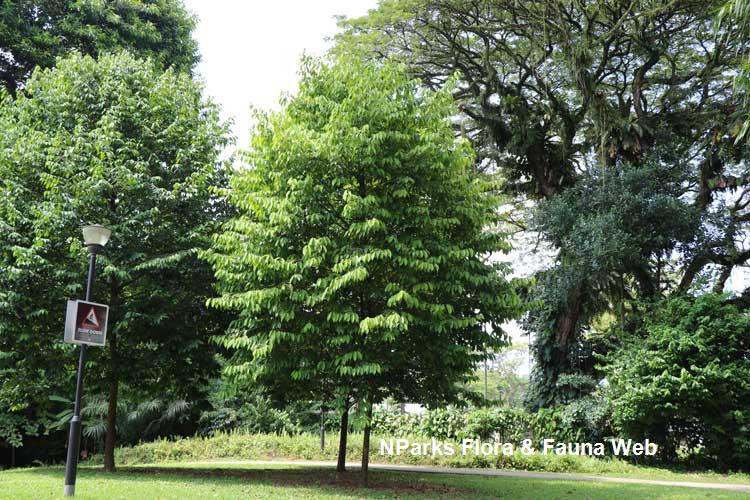.jpg)
Back
Colubrina asiatica (L.) Brongn
| Family Name: | Rhamnaceae |
| Synonyms: | Ceanothus asiaticus |
| Common Name: | Latherleaf, Peria Laut, Peria Pantai, 蛇藤 |
Name
Classifications and Characteristics
| Plant Division | Angiosperms (Flowering Seed Plants) (Dicotyledon) |
|---|---|
| Plant Growth Form | Shrub |
| Lifespan (in Singapore) | Perennial |
| Mode of Nutrition | Autotrophic |
| Plant Shape | Irregular |
| Maximum Height | 5 m |
Biogeography
| Native Distribution | India through Southeast Asia (including Singapore), and to China |
|---|---|
| Native Habitat | Terrestrial (Coastal Forest), Shoreline (Sandy Beach, Rocky Beach) |
| Preferred Climate Zone | Tropical |
| Local Conservation Status | Native to Singapore (Least Concern (LC)) |
Description and Ethnobotany
| Growth Form | It is a sprawling shrub or tree up to 5 m tall, with hanging branches. Some individuals may climb up trees. |
|---|---|
| Foliage | Its alternate, stalked leaves have saw-toothed edged leaf blades that are rather membranous or thinly papery, shiny dark green, egg-shaped, 3.8–8 by 2–5.7 cm, and tri-nerved at the bases. |
| Flowers | Its yellow flowers are 3.8 mm wide, and found in 5 mm-long clusters in the angles of leaves. |
| Fruit | Its round fruits are 7–9 mm wide, and split when ripe to release up to three greyish-brown seeds. Its dried fruit, and seeds are salt-tolerant and buoyant, being sea-dispersed. |
| Habitat | It grows in coastal habitats on rocky headlands or sandy beaches. In Singapore, it is found on inland sandy beaches, and offshore islands. It occurs locally in Pulau Pergam, the Western Catchment Area, Pulau Ubin, and Pulau Tekong, and other coastal vegetation sites. |
| Associated Fauna | Its flowers are insect-pollinated. The large seeds have been suggested as crop stones used by seed-eating birds, which may be responsible for their long distance dispersal. |
| Cultivation | It has attractive foliage and yellow flowers, tolerance for poor soil, rocky, and salt-spray conditions, and occasional sea-water inundation. It is suitable as a barrier plant, hedge, or screen, especially in coastal areas. It is can be propagated by seed. Under natural conditions, branches that come into contact with soil will root, so propagation by stem cuttings is also possible. |
| Etymology | Latin colubrinus, snake-like, referring to the appearance of the twisted stamens; Latin asiatica, Asian, a reference to the natural distribution of this species. |
| Ethnobotanical Uses | Edible Plant Parts : Edible Leaves Medicinal: The plant is said to be used in a decoction to induce abortion. Others: Its trunk has heartwood that is too narrow for commercial uses. Mats can be bleached and cleaned using the saponins in the bark. |
Landscaping Features
| Landscaping | It has attractive foliage and yellow flowers, tolerance for poor soil, rocky, and salt-spray conditions, and occasional sea-water inundation. It is suitable as a barrier plant, hedge, or screen, especially in coastal areas. |
|---|---|
| Desirable Plant Features | Ornamental Flowers |
| Landscape Uses | Coastal, General, Suitable for Roadsides, Parks & Gardens, Small Gardens, Beachfront / Shoreline, Hedge / Screening |
Fauna, Pollination and Dispersal
| Pollination Method(s) | Biotic (Fauna) |
|---|---|
| Seed or Spore Dispersal | Biotic (Fauna) |
Plant Care and Propagation
| Light Preference | Full Sun |
|---|---|
| Water Preference | Moderate Water |
| Rootzone Tolerance | Drought Tolerant, Saline Soils / Salt Spray, Poor Infertile Soils |
| Propagation Method | Seed, Stem Cutting |
Foliar
| Foliage Retention | Evergreen |
|---|---|
| Mature Foliage Colour(s) | Green |
| Mature Foliage Texture(s) | Glossy / Shiny, Papery |
| Foliar Type | Simple / Unifoliate |
| Foliar Arrangement Along Stem | Alternate |
| Foliar Attachment to Stem | Petiolate |
| Foliar Shape(s) | Non-Palm Foliage (Ovate) |
| Foliar Venation | Pinnate / Net |
| Foliar Margin | Serrate / Toothed |
Floral (Angiosperm)
| Flower & Plant Sexuality | Bisexual Flowers |
| Flower Colour(s) | Yellow / Golden |
|---|---|
| Flower Grouping | Cluster / Inflorescence |
| Flower Location | Axillary |
Fruit, Seed and Spore
| Mature Fruit Colour(s) | Brown |
|---|---|
| Fruit Classification | Simple Fruit |
| Fruit Type | Dehiscent Dry Fruit |
Image Repository
Others
| Master ID | 29370 |
|---|---|
| Species ID | 3679 |
| Flora Disclaimer | The information in this website has been compiled from reliable sources, such as reference works on medicinal plants. It is not a substitute for medical advice or treatment and NParks does not purport to provide any medical advice. Readers should always consult his/her physician before using or consuming a plant for medicinal purposes. |

.jpg)
.jpg)
.jpg)




